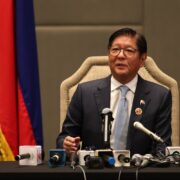Defensive and offensive weaponry

While Dec. 8 was not always a special nonworking holiday, it always was a school holiday for me. Growing up in the Ateneo, whose blue and white colors are a visual reference to the Virgin Mary, I always thought the Feast of the Immaculate Conception was universal. I was surprised to read that centuries ago it was not so, the Jesuits and Franciscans celebrated the feast in Intramuros while other religious orders did not, even remaining indoors during the fiesta and procession. I guess the significance of Dec. 8 differs depending on a person’s age or knowledge of history. On Dec. 8, 1941, the United States declared war on Japan after the attack on Pearl Harbor and, hours later, the invasion of the Philippines. For Filipinos at the time, Dec. 8, 1941 was the beginning of the Japanese occupation, a nightmare that they woke up from years later in 1945.
Looking back, if the Dutch successfully took Manila in 1646, if the British remained in Manila after 1764, if the Germans took over Manila Bay in 1898, today’s nonworking holiday would not be. My musings while treading Legazpi Village in Makati prompted a review of the historical sources. In the late 15th and early 16th centuries, Spain and Portugal sent ships beyond their borders in a race of “discovery” of a world unknown to them. To keep the peace, Pope Alexander VI divided the world in half like an orange, and gave one half of the unknown world to Spain, the other half to Portugal. I was not taught in kindergarten that the Philippines actually fell within the Portuguese line of demarcation, so when Miguel López de Legazpi claimed the Philippines for Spain in 1565, he was challenged by the Portuguese, that not only asked him to leave, the Portuguese even offered Legazpi and his men passage to India.
Documents from the Legazpi expedition make for engaging reading. For example, one of the difficulties they faced in forging friendly relations with the islanders in Cebu was not that they remembered Ferdinand Magellan and the 1521 Battle of Mactan, but rather the Spanish were confused with the Portuguese that killed many in Bohol. In 1568, Legazpi sent cinnamon to the King with a report that there was more to be had in the Philippines, including gold and wax, if he had articles to trade them for. In 1565, Legazpi issued an edict forbidding the raiding of graves for gold ornaments, instructing that whenever gold, pearls, and other valuable items were taken from the islands and their people, these had to be declared so the Crown could get its rightful share of the loot. Legazpi proposed that small ships be built in Cebu for exploration and trade further from his base. He also recommended the opening of mines to be worked on with slave labor.
Most readers will skip a long list of supplies requested on May 28, 1565 for the settlement in Cebu. On the wish list were articles for defensive and offensive warfare:
“12 pieces of heavy artillery, and among them culverins and reinforced cannon and swivel-guns for the fortress which is to be built, 50 bronze bersos [small culverins], of the sort brought from Spain, with double chambers, 20 falcons with double chambers, 12 new scaling ladders, Balls for the artillery and the molds for making them, 200 quintals of [gun]powder, 50 quintals fuses, 200 quintals lead, 50 quintals saltpetre, 30 quintals rock sulphur, 300 arquebuses [not of the worthless supply in Mexico]; and with them some with flints, all with horn powder-flasks [large or small] together with their molds and gear, that are to be in good condition, 100 corselets with their fittings, 200 morions and helmets, 50 coats-of-mail, of rather heavy mail, 100 tapir hides, 100 white blankets for light and serviceable body armor, 300 pikes with their iron points, 50 cavalry lances, 50 good broadswords, of which there is great need, 12 foreign cannoniers, for those whom we brought with us are of little account, 300 well-disposed soldiers who are to remain here, (a third or half of them to be sailors), 12 carpenters to build the vessels which must be built here, 2 smiths, with their forges and tools, 8 bellows with their tubes, 12 Negroes for these forges, and among them 4 sawyers, An artificer or two to make arquebuses and locks for them, 2 other locksmiths, 50 quintals tow, A surgeon and a physician, with their drugs; and 2 other Barbers, because only 1 remains here, 300 good shields, 200 quintals of wrought iron plates, not as it comes from the mine, 30 quintals finest steel, 100 tanned cow-hides, 300 pickaxes, 200 iron shovels, A royal ropemaker, who is in Mexico, 100 Venetian sail-cloths, 10 quintals of sailmakers’ twine, 2 bales of paper, 2 balances divided into 3 parts, 6 weights for large balances, and 50 horn lanterns.”
Warfare, 500 years later is different, but the situation Legazpi faced is similar to the supplies needed by one beached ship that stakes our claim to territory threatened by China.
—————-Comments are welcome at aocampo@ateneo.edu
Ambeth is a Public Historian whose research covers 19th century Philippines: its art, culture, and the people who figure in the birth of the nation. Professor and former Chair, Department of History, Ateneo de Manila University, he writes a widely-read editorial page column for the Philippine Daily Inquirer, and has published over 30 books—the most recent being: Martial Law: Looking Back 15 (Anvil, 2021) and Yaman: History and Heritage in Philippine Money (Bangko Sentral ng Pilipinas, 2021).

















